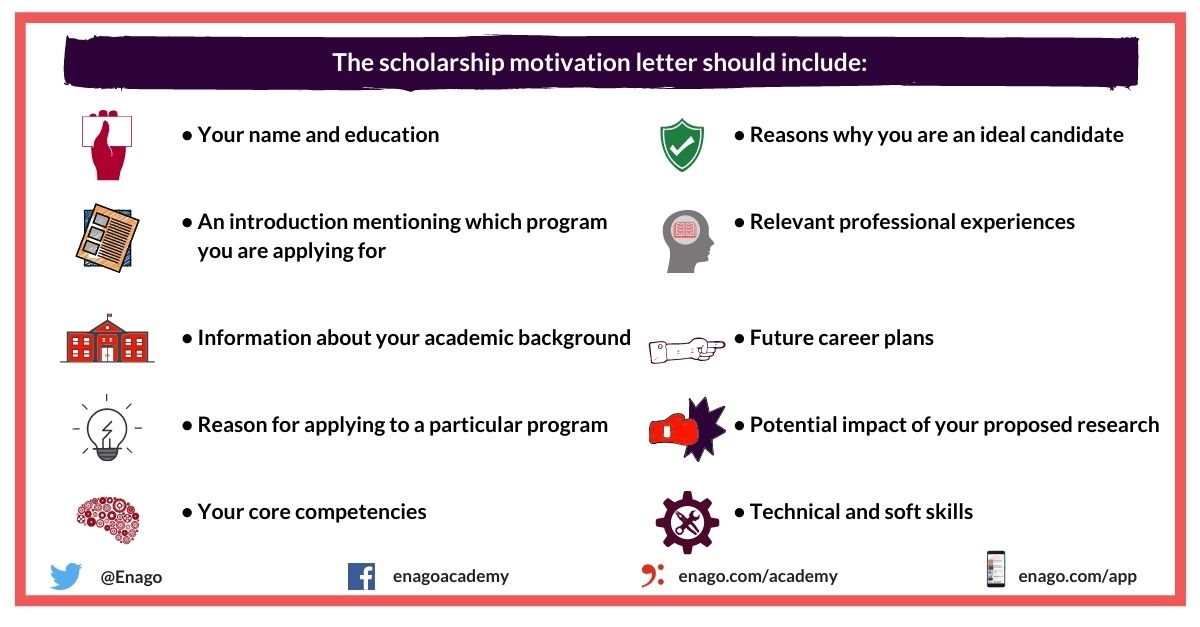How to Write an Exceptional Research Scholarship Motivation Letter

Haven’t heard from the scholarship committee yet? Another email of rejection? Numerous drafts, constant search for an ideal template, and yet couldn’t receive the scholarship? What could be the reason? The time and effort you put in writing personal statement and creating a powerful academic CV may have gone to vain, if the scholarship review committee never even saw it. And what do you think must have kept them from doing so? Yes, it is the scholarship motivation letter that you either didn’t care to write or if you did, it wasn’t compelling enough.
In today’s age, lack of financial ability must not serve as a hindrance in attaining higher education. With rising competition, your key to winning that scholarship is by drafting an exceptional letter of motivation to make you stand out from other applicants.
What is a Scholarship Motivation Letter?
A scholarship motivation letter is an opportunity to display your knowledge to the recruiter before you are called for an in-person interview. It speaks out some of the important aspects of your research proposal that connects it with your academic competence and personality. It is a crucial part that can make or break your application. Rather, it can be a deciding factor for the recruiters if you are eligible to be called for an interview.
A scholarship motivation letter is similar to a cover letter; it is not needed for every application; however, critical if mentioned specifically. Moreover, motivation letters are used to narrow down review committee’s pool of applicants.
Your scholarship motivation letter must answer the following questions:
- Why are you the ideal fit for the scholarship?
- How do your skills and abilities contribute to the university or your research field?
- How you plan to execute your education?
General Guidelines to Follow While Writing a Scholarship Motivation Letter
Generally, the application does not specify how long your motivation letter should be. However, you must use your best judgment to write a concise yet impactful scholarship motivation letter.
- It should usually range from 500 to 1,000 words.
- Divide them into 3 paragraphs for easy comprehension and better readability. This eases the job of the review committee members.
- Ensure the font is universally used, such as Times New Roman, Calibri, or Arial in a font size not smaller than 12.
What Should a Scholarship Motivation Letter Include?

What is the Scholarship Motivation Letter Format?
Since there is no standard structure for writing a motivation letter for scholarship, it has been a challenge to structure a convincing one. While the motivation letters may vary by universities and scholarship awards, the 3 consistent elements are an introduction, three content paragraphs, and a conclusion.
1. Introduction
- The introduction of your scholarship motivation letter should include a brief introduction specifying the program you would like to apply for and the reason for choosing it.
- It must clearly state objective of your future projects and career.
- Most importantly, your introduction must include your name and highest educational qualification so far.
2. Three Content Paragraphs
- The first paragraph of the main body of the motivation letter should include information about your academic and professional experience. Your professional experience may not only include academic related work such as teaching and research experience, but also work outside academic sector such as volunteering that demonstrates relevant skills and knowledge. Furthermore, this paragraph must showcase your career growth in chronological order. Finally, mention your professional ambitions you plan to achieve with education from this program.
- The second paragraph should explain what you hope to gain from your education. Furthermore, how you plan to contribute to the society and the problems you aim to solve with the help of your education. Emphasize on your willingness to improve career prospects and aspiration to discover and learn new things.
- The third paragraph should demonstrate your plans for the future. This could include additional knowledge or corresponding course you plan to pursue. You need to clearly describe what motivates you and what you would like to achieve as a result of your studies. Additionally, it should provide facts of your published work. Finally, display your soft skills and explain how they could be considered beneficial for your research conduction and for your field of study in general.
3. Conclusion
- While concluding, mention the impact your study/studies may have in your life, research area, and society at large.
- Explain how the scientific community and university can benefit from selecting you as a candidate for the program.
- Furthermore, state that you are aware of the competitive nature of the program and how you will be an asset to it.
- More importantly, it must reinstate how you are an ideal candidate and why must the selection committee choose you over other applicants.
Common Mistakes to Avoid When Writing a Scholarship Motivation Letter
Your scholarship motivation letter will probably be the first thing you are judged by. Hence, you should be scrupulous while writing and eventually submitting it. Beware of the common mistakes to avoid in the letter:
-
- It should be well-written with no grammar or spelling errors.
- Use a professional tone throughout the letter.
- Avoid slangs, clichés, colloquialisms, or jargon.
- Use of vague generalizations should be avoided.
- Avoid irrelevant information.
- Do not include false achievements.
- Avoid praising the university too much.
Key Takeaways
Since a scholarship motivation letter is your way to get through the review committee and convince them how you are an ideal candidate for the position, it must be written with a plan. Allow at least three days to write the letter. Get it reviewed from your colleagues or professors. Be your critic and edit it attentively.
Now it’s your turn to draft an award winning scholarship motivation letter. Refer to the scholarship motivation letter sample below and write one yourself. Let us know how these tips helped you.
Scholarship Motivation Letter Sample
9876 Boulevard St.
Oklahoma
United States of America
The Scholarship Committee
Department of Biological Sciences
Stanford University
United States of America
To Whom It May Concern:
My name is Steve Boult and I am a third year student at Oklahoma State University. I am currently pursuing a four-year Bachelor of Engineering Degree, and I plan to follow up with a one-year master’s degree after I graduate.
While in high school, I interned with a reputable chemical plant in the Research and Development department. I learned about the construction process of refineries from the ground up, and I discovered the importance of its function. I worked closely to develop and optimize the machinery to increase the output at the plant. Additionally, I volunteered at an NGO to design and implement new technologies in the water supply mechanism of the town.
My education is largely focused on this mindset: function over form, stability over showmanship. I have enrolled in several classes that amalgamates Chemical Sciences with Engineering in order to have a comprehensive view of how design meets structure. I have worked on four extra-credit chemical plant and oil refinery design projects under the supervision of my professors (Dr. A and Dr. B) to accelerate my research and education.
I believe in avoiding accidents than fixing the loss it causes. Thus, as an engineer, I want to create accessible, cost-effective, productive, and durable AI-based operational systems that inform us about the potential malfunctions in advance. Coming from a mechanical background, I believe that there is a need for an operational system that is reliable.
I appreciate your consideration. With your assistance, I can continue my schooling in engineering and design to put an end to uncalled for accidents in plants and other industries.
Sincerely,
Steve Boult










Thank you this was so helpful.